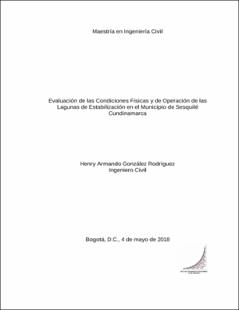| dc.contributor.advisor | Romero Rojas, Jairo Alberto ( dir) | spa |
| dc.contributor.author | González Rodríguez, Henry Armando | spa |
| dc.date.accessioned | 2018-07-27T20:51:08Z | spa |
| dc.date.accessioned | 2021-10-01T15:28:51Z | |
| dc.date.available | 2018-07-27T20:51:08Z | spa |
| dc.date.available | 2021-10-01T15:28:51Z | |
| dc.date.issued | 2018 | spa |
| dc.identifier.uri | https://catalogo.escuelaing.edu.co/cgi-bin/koha/opac-detail.pl?biblionumber=21459 | spa |
| dc.identifier.uri | https://repositorio.escuelaing.edu.co/handle/001/787 | |
| dc.description.abstract | El servicio de alcantarillado del municipio de Sesquilé Cundinamarca de tipo combinado tiene una cobertura del 100%, funciona por gravedad y cuenta con una longitud aproximada de colectores primarios de 1,22 km y de 7,03 km de colectores secundarios; el diámetro predominante es de 10 pulgadas, en su mayor parte usa gres como material de la tubería. Actualmente el perímetro urbano cuenta con dos sistemas de tratamiento de agua residual; el primero de ellos denominado PTAR I (objeto de este estudio) se realiza por medio de un sistema lagunar y el segundo sistema denominado PTAR II utiliza un reactor UASB, más un filtro biológico, sedimentación y desinfección.
La PTAR I (sistema lagunar) recibe aproximadamente el 60% de las aguas producidas del área urbana del municipio , vertiendo las aguas tratadas sobre la margen izquierda de la Quebrada los Murciélagos (vallado Achuri) y de ésta a un canal que descarga al río Bogotá. El 40% restante de la cabecera municipal, incluyendo las descargas de las veredas Boitivá, Boitá y parte de Nescuatá, cuenta con redes colectoras en diámetros entre 8 a 14 pulgadas y un emisario final de 16 pulgadas, el cual vertía directamente a un vallado que conduce a la quebrada El Pueblo. Recientemente se construyó la prolongación de dos colectores principales en tubería Novafor de 12 y 14 pulgadas de diámetro, provenientes tanto de la cabecera municipal como de las veredas Boitivá y Nescuatá, respectivamente, que confluyen a un emisario final que transporta las aguas directamente a la PTAR II en tubería de 16 pulgadas de diámetro.
El sistema de tratamiento lagunar se concibió como un método de tratamiento natural de lagunas facultativas, el cual fue optimizado al instalarle aireadores en las dos lagunas que lo componen.
La evaluación realizada al sistema, indica que provee una remoción mayor de 80% en DBO, SST, SSED, CF y CT; remoción de DQO del 79% y en grasas y aceites del 69%. | spa |
| dc.description.abstract | The sewerage service of the municipality of Sesquilé Cundinamarca of combined type has a coverage of 100%, operates by gravity and has an approximate length of primary collectors of 1.22 km and 7.03 km of secondary collectors; The predominant diameter is 10 inches, for the most part it uses stoneware as pipe material. Currently, the urban perimeter has two wastewater treatment systems; the first one called PTAR I (object of this study) is carried out by means of a lagoon system and the second system called PTAR II uses a UASB reactor, plus a biological filter, sedimentation and disinfection.
The WWTP I (lagoon system) receives approximately 60% of the water produced in the urban area of the municipality, discharging the treated water on the left bank of the Quebrada los Murciélagos (fenced Achuri) and from it to a channel that discharges into the Bogotá River. The remaining 40% of the municipal capital, including the discharges of the Boitivá, Boitá and part of Nescuatá districts, has collector networks in diameters between 8 to 14 inches and a final emissary of 16 inches, which poured directly into a fence that It leads to the El Pueblo stream. Recently, the extension of two main collectors was built in Novafor pipes of 12 and 14 inches in diameter, coming from both the municipal Headboard and the paths Boitivá and Nescuatá, respectively, which converge to a final emissary that transports the water directly to the WWTP. II in 16 inch diameter pipe.
The lagoon treatment system was conceived as a method of natural treatment of facultative lagoons, which was optimized by installing aerators in the two lagoons that compose it.
The evaluation made to the system indicates that it provides a removal of more than 80% in BOD, SST, SSED, CF and CT; removal of COD of 79% and in fats and oils of 69%. | eng |
| dc.format.mimetype | application/pdf | spa |
| dc.language.iso | spa | spa |
| dc.publisher | Escuela Colombiana de Ingeniería Julio Garavito | spa |
| dc.rights | Derechos Reservados - Escuela Colombiana de Ingeniería Julio Garavito | spa |
| dc.rights.uri | https://creativecommons.org/licenses/by-nc/4.0/ | spa |
| dc.subject | Planta de tratamiento de aguas | spa |
| dc.subject | Aguas residuales | spa |
| dc.subject | Tratamiento de agua | spa |
| dc.title | Evaluación de las Condiciones Físicas y de Operación de las Lagunas de Estabilización en el Municipio de Sesquilé Cundinamarca | spa |
| dc.type | Trabajo de grado - Maestría | spa |
| dc.type.version | info:eu-repo/semantics/publishedVersion | spa |
| oaire.accessrights | http://purl.org/coar/access_right/c_abf2 | spa |
| oaire.version | http://purl.org/coar/version/c_970fb48d4fbd8a85 | spa |
| dc.description.degreelevel | Maestría | spa |
| dc.description.degreename | Magíster en Ingeniería Civil con Énfasis en Recursos Hidráulicos y Medio Ambiente | spa |
| dc.publisher.program | Maestría en Ingeniería Civil con Énfasis en Recursos Hidráulicos y Medio Ambiente | spa |
| dc.rights.accessrights | info:eu-repo/semantics/openAccess | spa |
| dc.rights.creativecommons | Atribución-NoComercial 4.0 Internacional (CC BY-NC 4.0) | spa |
| dc.type.coar | http://purl.org/coar/resource_type/c_bdcc | spa |
| dc.type.content | Text | spa |
| dc.type.driver | info:eu-repo/semantics/masterThesis | spa |
| dc.type.redcol | http://purl.org/redcol/resource_type/TM | spa |
| dc.subject.keywords | Water treatment plant | spa |
| dc.subject.keywords | Sewage water | spa |
| dc.subject.keywords | Water treatment | spa |












